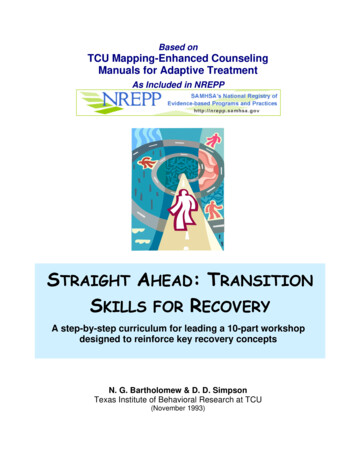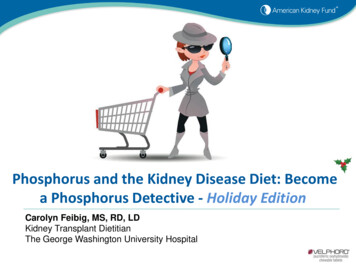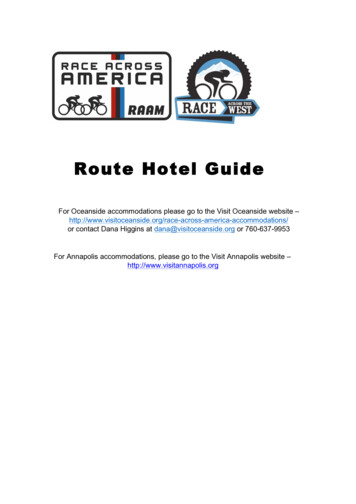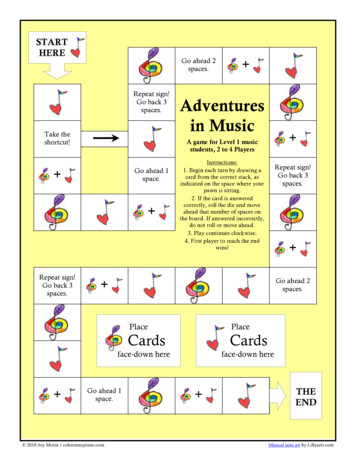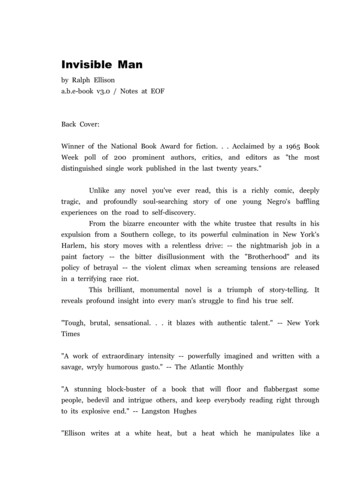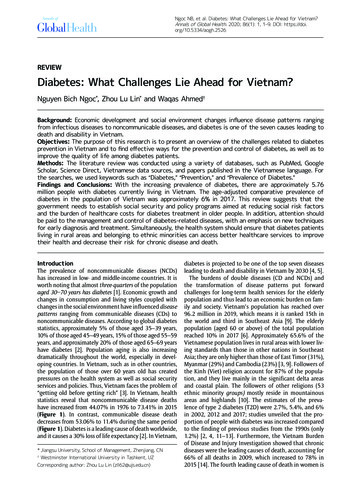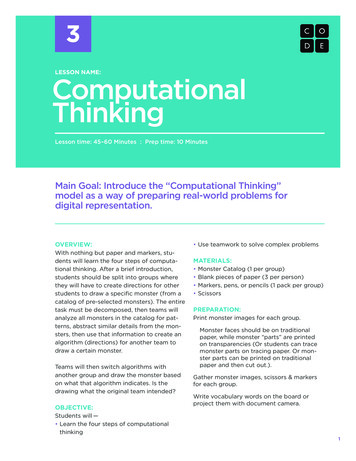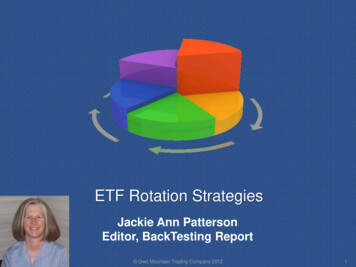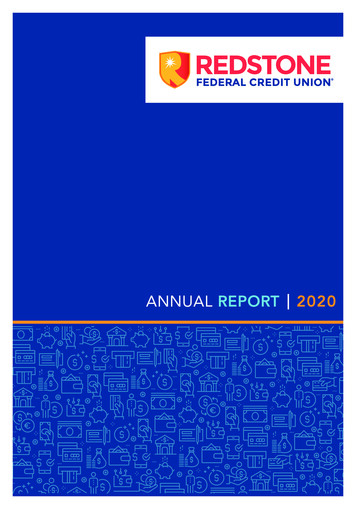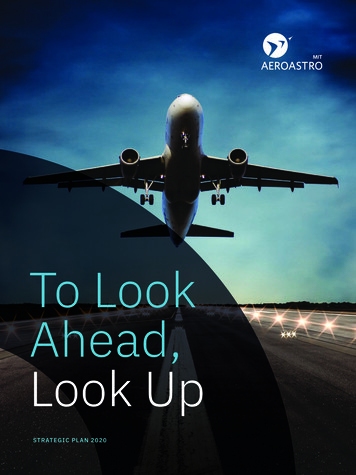
Transcription
To LookAhead,Look UpSTRATEGIC PLAN 2020
2STRATE G I C P L AN 2 0 2 0The future of humankind isinextricably linked to aerospace.In order to see further, wemust anticipate advances intechnology, education, andindustry. It requires a clear visionof the future we want to build,the core actions we take toachieve it, and the values thatwill guide us.This strategic plan charts ourcourse for the future. And welook ahead by looking up.
020406081012142224A RAPIDLY CHANGINGLANDSCAPEVISION & MISSIONOUR VALUESDEPARTMENT STRUCTUREFINDINGS & TRENDSCORE CAPABILITIESSTRATEGIC THRUSTSGRAND CHALLENGESSUMMARY
02STRATE G I C P L AN 2 0 2 0A Rapidly CLandscapeThe MIT Department of Aeronautics and Astronautics (MITAeroAstro) is a vibrant community of uniquely talented andpassionate faculty, students, researchers, administrators,staff, and alumni. As the oldest program of its kind in theUnited States, we have a rich tradition of technical excellence,academic rigor, and research scholarship that has led tosignificant contributions to the field of aerospace for morethan a century. Today, we continue to push the boundariesof what is possible to shape the future of air and spacetransportation, exploration, communications, autonomoussystems, national security, and education.In envisioning the next iteration of our Department’sstrategic plan, it was important to identify and address thecritical challenges for the aerospace enterprise over thenext 20 years. These challenges guide how we can bestinvest our resources in research and education to remaincompetitive, to leverage the unique academic environmentat MIT, and to have a tangible effect on the external world.The 2020 strategic planning process was a true team effortled by a steering committee (see page 25) with every cohortof our community weighing in to provide valuable feedbackas we envisioned the future of our Department together. Thisdocument aims to summarize these efforts, specifically regarding (1) changes to the external environment; (2) mission, visionand values; and (3) future strategic directions in research,education, and culture and leadership.
Growth of entrepreneurial aerospaceThe aerospace industry remains an important contributor toglobal economic activity and to research and innovation inthe United States and other countries. Entrepreneurship,especially from startups, has become a significant driver of thefield over the past decade and established industry playershave joined forces with wealthy individuals to establishnovel corporate venture arms. Game-changing technologicaladvances, such as increasingly autonomous vehicles, novelmanufacturing techniques, and new materials that enablenew vehicle design and operational concepts, have enableda democratization of aerospace. In addition, the pricepoint for significant activities in both air and space hasdropped considerably.MIT Schwarzman College of ComputingIn 2018, MIT announced the formation of the SchwarzmanCollege of Computing (SCC), the most significant structuralchange at MIT since the creation of the School of Humanities,Arts and Social Sciences in the late 1950s. A significantcomponent of the Department’s research program addresseschallenges in autonomy and computational engineering — bothof which will be key areas of focus in the SCC — because theyare integral to the future of aerospace.Demographics and inclusion in the aerospace fieldDiversity is a reliable and available source of new ideas, ingenuity and creativity in any field. However, there has been almostno change in the inclusion of women and under-representedminorities across the entire landscape of aerospace — undergraduate students, graduate students, and the professionalworkforce — in the past decade. The interplay of past, present,and future national demographics defines the pool of studentswho later become the faculty and staff who form the intellectualand cultural foundation of our community. For these reasons,diversity and inclusion must be a core value of the Departmentto be an inclusive home for people of all races, genders,religions, ethnicities and backgrounds.WHY IS A STRATEGICPLAN IMPORTANT?1. It guides faculty hiring, therebysetting the long-term directionsfor the Department.2. It outlines a vision for thefuture as a focal point for thefaculty, staff, students, andother Department stakeholders.3. It informs the allocation ofdiscretionary resources(money and space).STRATE G IC P L A N 2 0 2 0KEY DRIVERS OF THE STRATEGIC PLAN03Changinge
04STRATE G I C P L AN 2 0 2 0Vision & MVISIONThe vision of the MIT Department of Aeronautics andAstronautics is to create:An aerospace field that is a diverse and inclusive community,pushing the boundaries of the possible to ensure lastingpositive impact on our society, economy, and environment.MISSIONIn the MIT Department of Aeronautics and Astronautics, welook ahead by looking up. At its core, aerospace empowersconnection — interpersonal, international, interdisciplinary,and interplanetary. We seek to foster an inclusive communitythat values technical excellence, and we research andengineer innovative aerospace systems and technologies thathave world-changing impact. We educate the next generationof leaders, creative engineers, and entrepreneurs who willpush the boundaries of the possible to shape the future ofaerospace. We do these things while holding ourselves to thehighest standards of integrity and ethical practice. Workingtogether with our partners in public and private sectors, weaim to expand the benefits of aerospace to create a moresustainable environment, strengthen global security,contribute to a prosperous economy, and explore otherworlds for the betterment of humankind.
Created by an MIT-led team, the "D-8" conceptaircraft is designed to use 70 percent less fuelthan current commercial planes of its class.Image credit: Aurora Flight SciencesSTRATE G IC P L A N 2 0 2 0The mission outlines core actions takenby the Department to achieve our vision,which articulates our ideal future stateof the aerospace field.05Mission
06STRATE G I C P L AN 2 0 2 0OurValuesValues are fundamental beliefs ofan organization that guide behaviorand everyday decision-making.We acknowledge that while someof the values have been realized,others are aspirational.SUCCEED TOGETHERCREATE AN OPEN,DIVERSE, INCLUSIVE,AND SUPPORTIVECOMMUNITYWe aspire to nurture an open,diverse, and supportive community,which learns by inviting membersto give feedback and reflectingcollectively on how we meetour values.We collaborate across the growingMIT aerospace ecosystem, drawstrength from connectivity withthe broader MIT community, andproactively engage with nationaland international partners.
07MISSIONLEAD THROUGHEXCELLENCE INRESEARCH &EDUCATIONWe lead through the strength ofour research, the depth of learningour students achieve, andthe invention, innovation, anddiscovery from the interactionbetween research andeducation.ETHICS &INTEGRITYSTRATE G IC P L A N 2 0 2 0VISION
08STRATE G I C P L AN 2 0 2 0DepartmenStructureDEPARTMENT RESEARCH SECTORSComputingFields of study› Autonomous Systems› Communications and Networks› Controls› Aerospace Computational Engineering› Human-Autonomy CollaborationSpaceFields of study› Humans in Aerospace› Space Propulsion› Space Systems› Engineering SystemsAirFields of study› Air-Breathing Propulsion› Aircraft Systems Engineering› Air Transportation Systems› Aviation, Energy & Environment› Materials and StructuresA model of AeroAstro is shown to theright, which makes explicit the distinctionbetween the inputs (enablers) and theoutputs (impacts). It can be seen thatimpact has many facets, not only thetype of impact but in what sectors ofthe profession it touches.
09(Impacts)AlumniPublicationsConcepts & IdeasMethods & AFFInputs(Enablers)Undergraduate StudentsGraduate StudentsFundingFaculty HiresSTRATE G IC P L A N 2 0 2 0ntOutputs
Findings &TrendsStrategic control over spaceASTRONAUTICSNew space-based business modelsChallenges› An ecosystem of startups andnovel business models has beendisrupting industries and creatingnew products by driving innovation.Opportunities› Satellite-based Earth observation,remote sensing, and communications› Space launch companies› Manufacturing and mining in spaceSpace explorationChallenges› Private billionaires are investingheavily in space technologies andspace programs, contributing to arapidly changing ecosystem.Opportunities› Democratization of aerospace isleading to renewed enthusiasm andambitious new space ventures.Challenges› Past anti-satellite tests and satellitecollisions have shown the risks forrapidly increasing orbital debris.Increased access to space will generate more space debris, increasingthe likelihood of Kessler Syndrome,in which the high density of objectsin low Earth orbit collide, generating more debris that increases thelikelihood of a cascade where eachcollision increases the risk offurther collisions.Opportunities› Technical innovation in debris trackingand removal methodsHypersonic vehicles conceptsChallenges› “Hypersonic” refers to the ability to flyand controllably maneuver vehiclesmoving faster than the speed ofsound (at high Mach numbers) inthe atmosphere. Russia announcedthe successful deployment of itshypersonic glide vehicle, “Avangard”.This success could potentially posechallenges from a nationalsecurity standpoint, but it is a clearand marked demonstration thathypersonic vehicles are possible.Opportunities› Develop hypersonic vehicles andtechnologies for defense purposesto promote national securitySolutions for long-term space missionsChallenges› Issues need to be identified,including systems for energy andoxygen production.› Astronaut performance and safetyOpportunities› Nuclear power in space and in situresource utilization› Facilitate human spaceflight throughcountermeasures, mobility, life support systems, and radiation protection
11STRATE G IC P L A N 2 0 2 0&Members of NASA’s Mars 2020 project install theMars Oxygen In-Situ Resource Utilization Experiment(MOXIE) into the chassis of NASA’s next Mars rover.MOXIE will demonstrate a way that future explorersmight produce oxygen from the Martian atmospherefor propellant and for breathing.Image credit: NASA/JPL-CaltechUnmanned aerial vehicles (UAVs)Challenges› Urban air mobility (UAM) stillfaces significant implementationhurdles, specifically in urban areas(e.g. noise, traffic management,certification, safety).AERONAUTICSCommercial scheduled air transportChallenges› Rising energy prices and increasingenvironmental pressures› A number of startups plan tointroduce supersonic flightOpportunities› New technologies, such as novelairframe designs, materials, jetengines, and vehicle electrification› Sector projected to grow by 4-5 percent per annum, with growth focusedprimarily on emerging markets.› Emergence of new drone-basedbusiness models (e.g. for remotesensing or last-mile delivery).Opportunities› The common trend across UAV andUAM applications is the increase inautonomy at both the vehicle andsystem levels.› Expected to grow exponentially overthe coming decades. The FederalAviation Administration projects thefleet of small UAVs to triple over thenext few years.› The UAM market is projected to havea yearly market volume of 2.5B to 500B, and more than 70 manufacturers are currently working on potential vehicles for UAM applications.Infrastructure congestion andair traffic managementChallenges› Increasing traffic levels are leading tocapacity shortages, slowing marketgrowth in some world regions.› The estimated number of unaccommodated flights due to capacityshortages in Europe will reach 3.7Mper year by 2040.› The safe integration of autonomousoperations into the airspace systemremains a significant challenge. Asevidenced by the closure of LondonGatwick airport due to drone sightings, these new forms of demandcould create new safety challengesfor the aviation sector.Opportunities› Urban areas are expected to see adramatic increase in demand, withsome of them expected to experiencea 200x increase in the number offlights today due to unmannedaircraft systems operations, and a30x increase from UAM operations.
STRATE G I C P L AN 2 0 2 012Core Ca
In the 2015 plan, the Department identified a core set of capabilities necessary for the Department to maintain. These corecapabilities are essential for research and teaching in the field.These capabilities form the basis on which the cross cuttingstrategic emphases in research can be undertaken and allowthe Department to pivot to new areas as necessary. These are:1. The disciplines central to the design of aerospace vehicles(fluids, structures, energy conversion, materials);2. The discipline of real-time aerospace information sciences(guidance and navigation, estimation and control, autonomy,communications, networks);3. Advanced computation methods to support design anddecision-making (numerical simulation, high-performancecomputing, uncertainty quantification, inference);4. The disciplines essential to human-system collaboration(human-machine systems, human factors, supervisorycontrol and automation, biomechanics, life support);5. The sciences of atmosphere and space and how theyinform aerospace systems (environmental impact of aviation,environmental monitoring, science of space, spaceexploration); andAlejandra Uranga, Prof. Mark Drela, TechnicalInstructor David Robertson and graduatestudents Kevin Sabo and Trevor Longconstructed a 2x3 wind tunnel in The Hangarin Building 33. Image credit: Mark Drela6. The design, implementation and operation of complexaerospace systems (system architecture, safety, optimization,lifecycle costing).STRATE G IC P L A N 2 0 2 0Core capabilities arean organization's mainstrengths and strategic advantages — aunique combination ofpooled knowledgeand technical acumen.13apabilities
14STRATE G I C P L AN 2 0 2 0Strategic TStrategic thrusts are high-level initiatives pursued in tandemwith our core capabilities. They support the mission and visionand align with our core values. We have identified seven strategic thrusts that connect with and support our core capabilitiesand represent emerging areas of opportunity where we areuniquely positioned to lead and achieve major impact.The research thrusts focus on long-term trends (for example,the growing effect of aerospace on the environment) rather thanspecific systems. They build upon our strengths while anticipating future changes as the aerospace field continues to evolve(for example, increasing autonomy in aerospace, increasinguse of groups of satellites). The education thrusts respond toevident trends in education (for example, the impact of computing on the world more broadly) while the innovation and culturethrusts respond to the priorities of our students and alumni.OUR STRATEGIC THRUSTS ARE:Research thrustsThrust 1: Integrate autonomy and humans in real-world systemsThrust 2: Develop new theory and applications for satelliteconstellations and swarmsThrust 3: Aerospace environmental mitigation and monitoringEducational thrustsThrust 4: Lead development of the College of Computingeducation programs in autonomy and computational scienceand engineeringThrust 5: Develop education for digital natives anddigital immigrantsCulture & leadership thrustsThrust 6: Become the leading department at MIT in mentoring,advising, diversity, and inclusionThrust 7: Make innovation a key component in MITAeroAstro leadership
15STRATE G IC P L A N 2 0 2 0ThrustsThe Aerospace Controls Laboratoryresearches autonomous systemsand control design for aircraft,spacecraft, and ground vehicles.Image credit: Lillie Paquette
16STRATE G I C P L AN 2 0 2 0RESEARCHTHRUSTSTHRUST 1Integrate autonomy and humans inreal-world systemsWith the advent of deep learning throughartificial intelligence, human-autonomycollaboration is poised to transformthe aerospace sector radically, including vehicle manufacturing, the overallaviation system, and future militaryoperations. It will also help achieve thegoals set by the next generation of spacescience and exploration. Aerospacetechnologies, the design processes, andthe engineering practices are also drivingrapid innovation in autonomy in othersafety-critical, consumer-related sectors(e.g. autonomous cars, robotic deliveryvehicles, etc.) that have the potentialto significantly enhance human wellbeing and productivity. The demand forsecure, high-integrity systems will onlycontinue to grow, a trend we can alreadyTHRUST 2observe with large numbers of UAVs inthe airspace with piloted systems, atairports with robots loading and unloading aircraft, with air taxis coming close tovehicles on the ground, and in space asastronauts and robots increasingly worktogether. As these technologies mature,the transition and deployment intoreal-world environments (includingoperations in close proximity to humans)leads to significant new challenges inthe areas of trust, verification, and theintegration with new public policies.Thrust 1 will examine the developmentof trusted, verifiable, self-learning autonomous systems that can anticipate andwork with human behavior. The researchthrust will identify a set of focused challenge problems, engage policymakersaround these problems, and developnew methodologies for these problems.Develop new theory and applicationsfor satellite constellations and swarmsCost efficiencies and technologicaladvances have ushered in a new era oflarge-scale satellite constellations andswarms involving smaller satellites (suchas CubeSats). Swarms refer to two ormore spacecraft (up to a few dozen) thathave tight formation-flying requirementsin Earth orbit or beyond to accomplisha joint mission such as remote sensingvia interferometry, synthetic apertureradar, or distributed apertures. Constellations involve hundreds or thousands ofspacecraft covering the entire planet forremote sensing or telecommunicationswith either continuous n-fold coverage orvery short revisit times. These systemshave both interesting Earth-orientedapplications (for example, internetaccess) and space-oriented applications(for example, interferometry). The adventof smaller satellites poses new research
Thrust 3: A general blueprint for an MIT planepropelled by ionic wind. The system may be used topropel small drones and even lightweight aircraft,as an alternative to fossil fuel propulsion.Image credit: MIT Electric Aircraft InitiativeTHRUST 3challenges and opportunities aroundtrade-space analysis and optimization,autonomous research operations, newtechnology development, and spacesituational awareness and spacetraffic management.In Thrust 2, the application of smallsatellite clusters (homogeneous andheterogeneous) will be explored in alltheir dimensions. The range of possibilities is vast, including new architecturalconcepts in space (for example, reconfigurability, federation, and disaggregation)as well as in-space servicing, assembly,and manufacturing. The Department willaddress the entire suite of possibilitiesfrom conception to operation of thesesystems. A critical element is how toensure cybersecurity for these systems.One important metric is the formationof a small satellite center to focus theeffort in the Department.Aerospace environmental mitigationand monitoringAddressing anthropogenic environmentaland climate challenges is the moonshotof our generation. The aerospaceindustry is often considered a significantcontributor to anthropogenic climatechange. At the same time, aerospacetechnologies can serve humanity inunderstanding and mitigating ourenvironmental footprint. Currently,satellites play a significant role in Earthobservation since they provide muchof the data required for analyzing andunderstanding the anthropogenic climateimpacts, both in terms of emissions andclimate impacts on Earth’s systems:oceans, land, air, and near space. Ourunderstanding of processes in the Earth’satmosphere particularly benefits fromcontinuous remote monitoring andsensing — especially in combinationwith novel artificial intelligenceapproaches that enable us to analyzeand visualize large amounts of data in(near-) real time. Other applicationsfor aerospace-enabled environmentalmonitoring approaches with satellites,high-altitude planes, pseudo-satellites,balloons, or drones can includemonitoring air quality, traffic flows,disasters, or compliance.Thrust 3 includes monitoring as wellas mitigation, with potential impactareas that range from the health of ouratmosphere to oceans to biodiversity,and more. Specifically, we identifiedopportunities in reducing the environmental impact of aerospace systems (airand space), using aerospace systems formonitoring, designing for efficiency toreduce impact, implementing autonomy,artificial intelligence, and computationalengineering, and understanding andmitigating environmental impacts.STRATE G IC P L A N 2 0 2 0Thrust 2: The SpaceX Starlink mission is a satelliteconstellation that aims to expand internet accessacross the globe. Image credit: U.S. Air Force photoby 1st Lt. Alex Preisser17Thrust 1: The Sensing, Perception, Autonomy, andRobot Kinetics (SPARK) develops the algorithmicfoundations of robotics through the innovativedesign, rigorous analysis, and real-world testing ofalgorithms for single and multi-robot systems.Image credit: Lillie Paquette
18STRATE G I C P L AN 2 0 2 0EDUCATIONTHRUSTSTHRUST 4Lead development of the College ofComputing education programs inautonomy and computational scienceand engineeringThe Department has considerablefaculty strength in autonomy (includinghuman-robot interactions) and computational science and engineering. Bothareas are also vital to a modern view ofaerospace engineering and must includeissues such as how to enable humansto perform higher level tasks and cybersecurity. In light of these considerations,the Department will continue to developand offer degree programs in autonomyand in computational engineering. Thesedegrees will be cross-listed in the SCCand will be supported by the College aswell as the Department.Image credit: Lillie Paquette
19Thrust 5: Image credit: Lillie PaquetteTHRUST 5Develop education for digital nativesand digital immigrantsThanks to the widespread availabilityof learning resources on the internet,many students arrive on their first dayat MIT armed with digital skills that farsurpass those of previous generations. Inparticular, they know how to navigate theinternet to locate information, they canorganize online collaboration for classprojects, and they know how to createpresentations. Traditional teachingmethods often do not take advantageof all the new ways students have oflearning. If we can align our teaching andleverage the digital skillset of incomingstudents, we will improve students’overall educational experience, creatingan opportunity for leadership both atMIT and globally. In addition, the digitalworld enables us to develop professionaleducation opportunities for alumni andothers that provide tailored means tolearn about new fields.With Thrust 5, we aim to bring the bestlecturers and content to the studentswhile allowing for more flexible organization of the actual course work. TheDepartment will explore the development and deployment of a library ofdigital nuggets by producing high-quality,short and modular aerospace engineering content that are de-contextualizedand pedagogically aligned so they canbe easily repurposed and integratedacross multiple platforms. This includesshort course materials, videos, tests,experimentation, etc., in stand-alonebricks that take five to 25 minutes tocomplete and can be included in anyteaching form.STRATE G IC P L A N 2 0 2 0Thrust 4: The Interactive Robotics Group usesrobots such as Robotina to understand human-robotinteraction. Image credit: Joseph Lee/Office ofGraduate Education
20STRATE G I C P L AN 2 0 2 0CULTURE &LEADERSHIPTHRUSTSTHRUST 6Become the leading department atMIT in mentoring, advising, diversity,and inclusionDespite a rich history of technical andhuman achievement, one area wherethe aerospace field has fallen shortconsistently is in the inclusion of womenand minorities.Prof. Wesley Harris withAeroAstro PhD studentLawrence Wong.Image credit: Joseph Lee/Office of Graduate EducationThe overall conclusion is that the Department, like the national aerospace field,is challenged in inclusion at every level.Data from the MIT academic climatesurvey indicates that the experience ofwomen faculty is, on average, worsethan male faculty. The same also holdstrue for women graduate students in thePhD program. Our enrolled student surveys tell us that our graduate studentsexpress a desire for more frequent and
21Thrust 7: Optimus Ride, a startup out of MIT, runsa fleet of self-driving vehicles that operate in areasthe company comprehensively maps, or geofences.Prof. Sertac Karaman co-founded the company withseveral MIT alumni. Image credit: Optimus RideSTRATE G IC P L A N 2 0 2 0Thrust 6: Prof. Carmen Guerra-Garcia, whoseresearch focuses on applications of plasmas inaerospace, tests a plasma generation and electricalmeasurement system with graduate students, ColinPavan and Yiyun Zhang. Image credit: Lillie PaquetteTHRUST 7better advice and mentoring from thefaculty. Further, we also have a retentionissue for women faculty, and a relatedset of issues for women graduatestudents. Our staff focus groups alsotell us that staff do not feel included inthe Department.In Thrust 6, the Department will committo becoming the Institute leader in diversity, inclusion, advising, and mentoringat every level for every group in ourcommunity. We will examine and adoptthe best practices through research,discovery, experimentation, and self-examination, and we will track our progresswith rigor. These efforts will require closecollaboration with the Office of the ViceChancellor, the associate provost and theInstitute community and equity officer.Make innovation a key component inMIT AeroAstro leadershipThe Department has a long history ofinnovation and solving critical problems;examples range from pioneering workin the early days of flight to fundamentalcontributions to the Apollo missions. AsSilicon Valley and large tech companiesare driving innovation and entrepreneurship on the West Coast, AeroAstro iswell-positioned to create a similar,entrepreneurial environment thatencourages out-of-the-box thinking andrealizes the potential of the researchproduced by the Department. PositioningAeroAstro as leaders in innovation willenable our Department to continue toattract and retain the best studentsand faculty while making substantialcontributions to the field of aerospace.The focus of Thrust 7 is the cultivationand promotion of the innovative spiritthat our department is known for andthe dissemination of new innovations inaerospace that the Department producesto local, national, and internationalcommunities. We will also commit toinnovate through education by findingnew ways to effectively educate the nextgeneration of students. There is a broadinnovation ecosystem available to leverage at MIT, and we will aim to strengthenour connection to this ecosystem.
22STRATE G I C P L AN 2 0 2 0Grand CThe Space PropulsionLaboratory engineers tiny,highly-efficient electrosprayspacecraft thrusters thatimprove the maneuverabilityof small satellites.Image credit: Sara Cody
POTENTIAL GRAND CHALLENGESZero space debrisThe near-earth space is increasingly contaminated with spacedebris ranging from dead satellites to spent boosters to piecesof space systems. The problem is likely to grow substantiallyas the number of active satellites grows due to the launchof large constellations. The vision is to engineer a technicalsystem that would interact with the debris (perhaps remotely)to either bring it down or to move it to a place where it can berepurposed, assuming this made economic and policy sense.The goal is to arrive at a state where there is zero space debrisaround the earth.Turing test for UAVsThe Turing test for computers provides a benchmark thatwill indicate when machines exhibit truly intelligentbehavior — when it is indistinguishable from that of a human.For a UAV to pass a Turing test, a remote observer of a UAVflying in a complex environment (e.g. landing and taking offfrom an uncontrolled airfield in a complex airspace) would beunable to differentiate if it was remotely piloted or if it waspiloting itself via artificial intelligence.Urban air mobilityUrban air mobility (UAM) holds much promise to alleviatecongestion by moving a significant fraction of commuters fromthe roads and into the air. Currently the most popular vision isvertical takeoff and landing (VTOL) vehicles with multiple rotorsdriven by electric motors, powered by some combination ofbatteries and turbo-electric generators. But since many smallrotors cannot perform an autorotation descent, the requiredflight-critical power redundancy makes UAM VTOL vehicleshave nearly twice the gross weight for a given payloadcompared to fixed-wing aircraft, and also have inferior speedand range capability. The objective of this grand challenge is todevelop a super short takeoff and landing (SSTOL) fixed-wingaircraft with blown lift, which can operate from extremelysmall airfields, even from heliports.STRATE G IC P L A N 2 0 2 0A “grand challenge”is a large, long-rangecollective effort ofa number of thefaculty membersthat addresses animportant challengeof the field.23Challenges
24STRATE G I C P L AN 2 0 2 0As we look ahead to the future,we embrace our challengesand opportunities to shootfor the stars.AeroAstro PhD studentsTim McGrath and JeremyStroming test out theirmicrogravity erg machineduring a MIT Media Lab SpaceExploration parabolic flight.Image credit: Steve Boxall/Space Exploration Initiative
This strategic plan positions theDepartment well for the next severalyears by responding to key
STRATEGIC PLAN 2020 2 The future of humankind is . inextricably linked to aerospace. In order to see further, we must anticipate advances in technology, education, and industry. It requires a clear vision of the future we want to build, the core actions we take to achieve it, and the values that will gu
